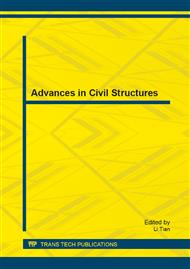p.570
p.574
p.578
p.583
p.587
p.592
p.596
p.601
p.610
Debonding Behaviors of CFRP Strengthened RC Beams with Weak Interfaces
Abstract:
Debonding behaviors of CFRP strengthened RC beams were experimentally investigated under the influence of weak interfaces, which are induced either by defective bonding of replaced cover or expansive cracks. Shown by test results, weak interfaces impaired considerably the structural integrity of strengthening systems during loading, and easily led to CFRP debonding failure. U-strips worked effectively in preventing the integral debonding and guarantee the structural performance of flexural sheets. However, local cover delamination in the loading process and premature rupture of flexural CFRP could still take place due to the weak interface effects. Therefore, allowable tensile strain of flexural CFRP should be reduced, and more strict confinement and anchorage measures should be taken in this case.
Info:
Periodical:
Pages:
587-591
Citation:
Online since:
August 2013
Authors:
Price:
Сopyright:
© 2013 Trans Tech Publications Ltd. All Rights Reserved
Share:
Citation:


